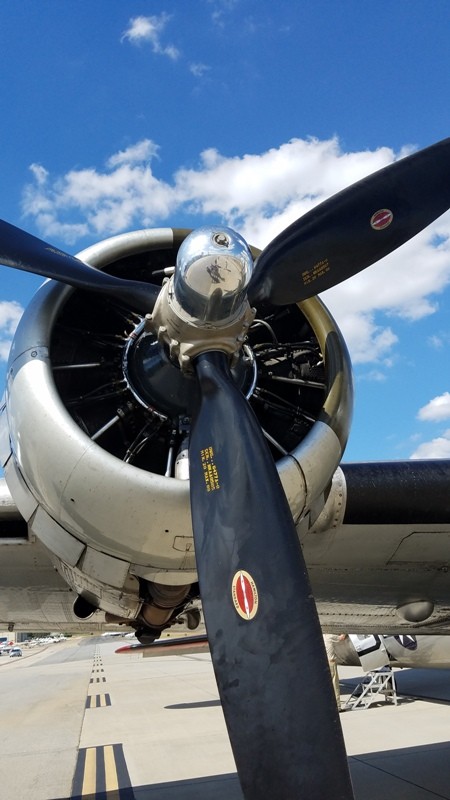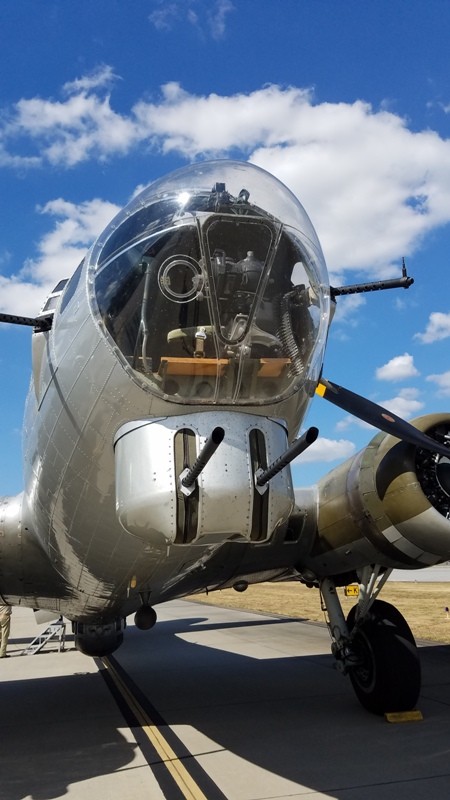Contact Bill at [email protected]
I am an artifact addict. Not a scholar, historian, or researcher, mind you, but an artifact addict. Seeing and touching items from another time transports me back in time. It gives me a better understanding of what it was like “back then,” more so than reading a book or seeing documentary.
The object at hand this time is the B-17 Flying Fortress known as the Aluminum Overcast. It is 65-thousand pounds of history that still takes people up in the air and back in time. I was privileged to experience the Overcast when the Experimental Aircraft Association’s tour brought it to Peachtree-DeKalb Airport.
The Aluminum Overcast winters in Oshkosh, Wisconsin at EAA headquarters in a toasty hanger. During spring and fall it tours the country giving people a taste of one of the amazing machines that fought for our freedom during WWII. According to the EAA website, this particular B-17 was produced near the end of the war and never saw combat. It was sold as surplus in 1945 for all of $750 and has logged more than one million miles. It saw service as a cargo hauler, crop duster, and aerial mapping platform before being purchased in 1978 as part of a project to preserve B-17’s.
B-17’s were equipped with 13.50 caliber machine guns each loaded with 1,000 rounds. The belts of bullets that fed the guns were 27-feet long, or nine yards. When gunners ran out of bullets on a mission it was called going the “whole 9 yards”. And all this time you thought it was a football reference…me too. Those guns were also what caused a Seattle reporter to call the B-17 a “flying fortress”.
Getting a close look at the plane on the tarmac was exciting; climbing inside was an over-the-top experience. Strapped in one of the rear seats waiting for the crew to wake the four sleeping engines, you notice how spartan the interior is. It is a quick reminder that these planes were built for a specific job…a deadly serious job…and creature comforts add weight which can waste a lot of fuel.
Within a few minutes hatches were secured and one by one the engines roared to life. The entire airframe shuddered before settling into a regular rhythm that was almost comforting. Soon we were rolling down the runway deafened by the sound of raw power. A slight sway and the sound of landing gear being retracted meant another successful take off for the Aluminum Overcast.
Once airborne, we were allowed to unbuckle our seatbelts and explore the aircraft. That included standing by the guns mounted amidships and looking down the barrel searching for enemy aircraft. Moving aft we saw the radio operator’s station and stood where the top gun turret once was mounted. The turret has been removed so passengers can more freely investigate the craft. The cockpit has been updated slightly to allow for the use of more modern navigational electronics. Just below the cockpit, you ease down into a short tunnel and make your way to the famous glass nose where the bombardier sat. We were told that the clear front made him the prime target for enemy fire: deadly seat, beautiful view.
The entire time I couldn’t stop from saying, “Amazing,” that is until I was back in my seat preparing to land. I allowed my mind to wander and try to see this through the eyes of those brave and capable men who flew in these birds…fought in these birds…and too often died in them. Suddenly the word “amazing” took on an entirely new context and a quieter less gleeful tone. What it must have been like to be a 20-year-old getting ready to take off on a mission. You’re bundled up in your flight suit, which on the ground has you sweating, but you’ll need it at an altitude where the temperatures are well below zero. There is no insulation in the plane, however, your suit is sort of a wearable electric blanket with heating elements. You plug it into the outlet near your station and hope your sweat doesn’t cause a shock. You occasionally lift your oxygen mask to allow pieces of ice from sweat and condensation to fall out in hopes of getting some relief. But most of all….most of all…you hope to make it back alive.
Fact: 4,735 B-17’s were lost in combat. Each plane had 10 crew members. One could surmise that a lot of life was lost as a result of the planes going down however, I heard during our flight that three of 10 crew members were actually killed in combat, their fellow crew having to remove their bodies once they returned to base.
I now have a better understanding of the term “Greatest Generation”. These were determined men and women who fought the war on the front lines and worked at home to keep the troops supplied. In fact, good ole American “just do it” was cranking out sixteen B-17’s a day.
I asked one of our EAA crew what the men who flew these planes had to say when they came to visit. Obviously their numbers are greatly diminished, but the crew said they still get an occasional visit from a flyer and his family. He said that often they will start telling stories about their time in the air and in combat. Many times the family will comment to the tour guides that dad or grandpa had never really talked about his time in the war before the visit. I was told that one former flyer shared the story of how one of his crew died in his arms. When his tour flight was over, he went to the back of the aircraft and saluted his fallen friend.
You can see and take a ride on the Aluminum Overcast this weekend, Oct. 6-8. From Peachtree-DeKalb it goes to Columbus, Ga. Here’s a link to the tour schedule and the EAA website where you can find out more. https://www.eaa.org/en/eaa/flight-experiences/aluminum-overcast-eaa-b-17-bomber-tour/b-17-aluminum-overcast-tour-stops
But if you go, once you get over the initial excitement of being airborne in such an amazing craft, take a moment to look at it through the eyes of a 20-year-old heading out on a mission, and listen for the sound of enemy fire. Then thank God it's just your imagination….and thank that 20 year old for the sacrifices of the Greatest Generation.
Read more about this event and plane inScott Kimbler's report and check out the video http://bit.ly/2hUPDjS



http://accesswdun.com/article/2017/10/591046/discovering-another-meaning-for-the-word-amazing
